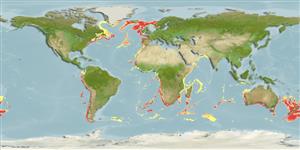Preferred temperature (Ref.
115969): 3.5 - 8.4, mean 6.6 (based on 754 cells).
Phylogenetic diversity index (Ref.
82804): PD
50 = 0.5000 [Uniqueness, from 0.5 = low to 2.0 = high].
Bayesian length-weight: a=0.02239 (0.01607 - 0.03118), b=3.08 (2.98 - 3.18), in cm Total Length, based on LWR estimates for this species (Ref.
93245).
Nivel trófico (Ref.
69278): 4.3 ±0.1 se; based on diet studies.
Resiliencia (Ref.
120179): Muy bajo, población duplicada en un tiempo mínimo superior a 14 años (K=0.04-0.06; tm=5-33; tmax=140; Fec=10,000).
Prior r = 0.07, 95% CL = 0.05 - 0.11, Based on 3 full stock assessments.
Fishing Vulnerability (Ref.
59153): High to very high vulnerability (72 of 100).
Climate Vulnerability (Ref.
125649): Moderate to high vulnerability (54 of 100).
